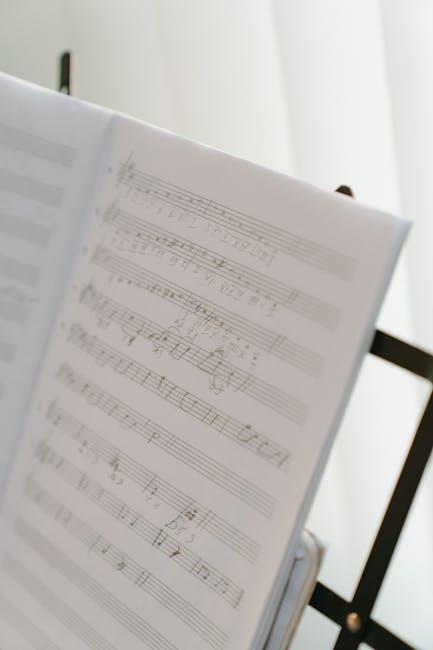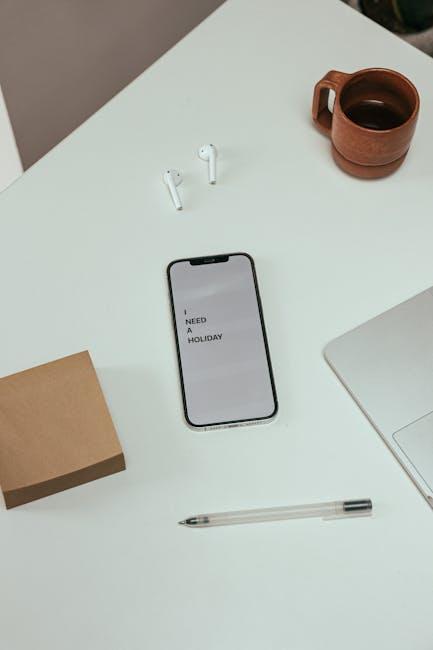In a world filled with constant distractions and a never-ending to-do list, finding ways to sustain focus and boost productivity has become a modern-day quest. Among the many tools we reach for—apps, planners, caffeine—music offers a unique and often overlooked ally. Beyond mere background noise, certain melodies and rhythms have the power to tune our minds, sharpen attention, and enhance cognitive performance. This article explores the fascinating interplay between music and productivity, uncovering how the right soundtrack might just be the key to unlocking your most focused self.
Table of Contents
- The Science Behind Music and Concentration
- Choosing the Right Genres to Boost Productivity
- How Tempo and Rhythm Impact Your Focus
- Creating Personalized Playlists for Deep Work Sessions
- The Role of Instrumental and Ambient Sounds
- Integrating Music Breaks Into Your Work Routine
- Q&A
- In Retrospect

The Science Behind Music and Concentration
Scientific studies reveal that music can modulate brainwave patterns, particularly alpha waves, which are linked to relaxed alertness—a state optimal for concentration. When the brain receives melodic, rhythmic stimuli, dopamine levels increase, enhancing motivation and mood. This biological response creates a feedback loop that sustains focus and minimizes distractions, allowing complex tasks to be tackled more efficiently. In particular, instrumental tracks or music with a steady tempo help synchronize neural activity without overwhelming cognitive resources.
Key factors influencing how music affects productivity include:
- Tempo: Moderate beats around 60-80 BPM tend to support working memory and creativity.
- Complexity: Simpler arrangements reduce cognitive load and prevent multitasking interference.
- Personal preference: Familiarity and positive associations enhance concentration for individual listeners.
| Music Attribute | Effect on Concentration |
|---|---|
| Steady Rhythm | Enhances focus and task persistence |
| Lyric-free | Minimizes verbal distraction |
| Moderate Volume | Balances stimulation and calmness |
| Instrumental Genres | Reduce cognitive interruption |

Choosing the Right Genres to Boost Productivity
For those aiming to enhance concentration and maintain motivation, selecting the right style of music can make all the difference. Instrumental tracks, particularly classical and ambient genres, often provide a non-intrusive background that helps keep your mind engaged without overwhelming your cognitive resources. If lyrics prove distracting, opt for music that emphasizes rhythm and texture rather than vocal melodies—this approach fosters a soothing atmosphere ideal for intensive tasks.
Consider these popular genres known to elevate productivity:
- Lo-fi beats: Smooth and repetitive, perfect for creating a relaxed but focused environment.
- Jazz instrumentals: Offers dynamic energy with intricate melodies that stimulate creativity.
- Nature sounds blended with music: Enhances calmness and can reduce stress during work sessions.
- Electronic ambient: Provides a modern, minimalistic vibe that supports extended periods of concentration.
| Genre | Best For | Why It Works |
|---|---|---|
| Classical | Deep focus and studying | Complex yet non-distracting harmonies |
| Lo-fi | Casual work and breaks | Relaxing, repetitive beats maintain flow |
| Ambient | Stress reduction and creative tasks | Subtle textures soothe and inspire |
| Jazz | Creative brainstorming | Expressive, energizing instrumentals |

How Tempo and Rhythm Impact Your Focus
The interplay between tempo and rhythm is a subtle yet powerful influence on your ability to stay concentrated. When the tempo is too fast, it might cause anxiety or distract you, speeding up your thoughts in an uncontrolled way. Conversely, a slow tempo can help relax your mind, promoting a steady flow of focus without rushing. The ideal beat allows your brain to sync with the music, creating a harmonious background that fosters productivity without demanding your attention.
Rhythm, the pattern of sounds and silences, adds structure that your brain naturally responds to. Regular, predictable rhythms can enhance your cognitive performance by providing a consistent auditory anchor, keeping wandering thoughts at bay. Consider these aspects when choosing your work soundtrack:
- Consistent beats: Promote mental clarity and sustained attention.
- Subtle variations: Prevent monotony and refresh alertness over time.
- Tempo range: Moderate pace (60-90 BPM) often strikes the right balance for deep work.
| Tempo | Effect on Focus | Example Uses |
|---|---|---|
| Slow (40-60 BPM) | Calms and soothes, good for creative brainstorming | Ambient, classical adagios |
| Moderate (60-90 BPM) | Enhances concentration, steady mental pacing | Lo-fi beats, mid-tempo electronic |
| Fast (90+ BPM) | Can increase energy but may distract | Upbeat pop, fast-paced instrumentals |

Creating Personalized Playlists for Deep Work Sessions
To maximize concentration during deep work sessions, curating your own playlist tailored to your unique rhythm can be a game-changer. Begin by selecting tracks that have steady tempos and minimal lyrics, allowing your brain to dive into complex tasks without verbal distractions. Experiment with different genres—from ambient electronic to soft classical—and identify which sonic textures help your focus sharpen. Incorporate a mix of instrumental pieces and nature sounds to create a soundscape that nourishes your cognitive flow.
Maintaining a balanced playlist ensures your mind stays both energized and serene. Below is a simple guide to assembling your ideal deep work soundtrack:
- Tempo: Choose songs around 60-80 BPM to promote calm alertness.
- Lyrical content: Prefer instrumental or non-intrusive vocals.
- Variety: Blend genres such as jazz, lo-fi beats, and ambient sounds.
- Duration: Aim for playlists that span 1.5 to 2 hours to avoid interruptions.
| Genre | Ideal Use | Example Artists |
|---|---|---|
| Ambient | Background atmosphere | Brian Eno, Moby |
| Lo-fi Hip Hop | Loosening focus, creative spikes | Jinsang, Nujabes |
| Classical | Structured tasks, analytical work | Ludovico Einaudi, Bach |
| Nature Sounds | Mild relaxation and stress relief | Ocean waves, Rainforest |

The Role of Instrumental and Ambient Sounds
When it comes to optimizing your work environment, instrumental music serves as a powerful ally. Without the distraction of lyrics, instrumental tracks allow your brain to focus more deeply on tasks, whether it’s analytical work or creative brainstorming. The melodies often provide a subtle rhythm that can help maintain steady energy levels, reducing the feeling of mental fatigue. This kind of soundscape is especially effective for activities that demand sustained concentration, from writing reports to coding.
On the other hand, ambient sounds create an enveloping atmosphere that masks disruptive background noises, promoting a sense of calm and flow. These sounds often mimic natural environments—like rain, ocean waves, or forest whispers—helping to reduce anxiety and mental clutter. Consider the following benefits that ambient sounds bring to a productive workspace:
- Enhances relaxation without dulling alertness
- Improves mood through soothing auditory cues
- Facilitates transitions between tasks by resetting focus
- Creates a personalized sound environment adaptable to different work styles
| Sound Type | Best For | Effect |
|---|---|---|
| Instrumental | Analytical and creative tasks | Boosts focus and energy |
| Ambient | Reducing distractions & anxiety | Promotes calm and flow |

Integrating Music Breaks Into Your Work Routine
Scheduling short musical interludes throughout your workday can do more than just break monotony — it can actively rejuvenate your mind. Consider playlists curated specifically for quick energy boosts or calming melodies to counter midday stress. The key lies in timing these breaks to align with natural dips in concentration, allowing your brain to reset without losing momentum. For instance, a 5-10 minute instrumental session after every 90 minutes of focused work can significantly enhance mental clarity and creativity.
To optimize these sessions, try creating a personalized rotation of genres and tempos. Here’s a simple guide to match music styles with break purposes:
- Upbeat Pop or Dance: Invigorate and uplift your mood.
- Classical or Ambient: Promote relaxation and mental decluttering.
- Nature Sounds or Chillhop: Foster calmness and subtle rejuvenation.
| Break Time | Recommended Music Type | Benefit |
|---|---|---|
| Mid-Morning (10-15 min) | Upbeat Pop | Energy boost & mood lift |
| Lunch Break (15-20 min) | Ambient or Classical | Relaxation & mental reset |
| Afternoon (10 min) | Nature Sounds | Stress relief & calm focus |
Q&A
Q&A:
Q: Can music really help improve focus and productivity?
A: Absolutely. Music can serve as a cognitive backdrop that minimizes distractions, enhances mood, and promotes a state of flow—making it easier to concentrate and work efficiently.
Q: What types of music are best for boosting productivity?
A: Instrumental tracks, ambient sounds, classical music, and even certain electronic genres like lo-fi beats are popular choices. These styles often lack distracting lyrics and feature steady rhythms that help maintain a steady mental pace.
Q: Is there a particular tempo or rhythm that maximizes focus?
A: Generally, songs with a tempo between 60 to 80 beats per minute align well with the brain’s natural alpha waves, fostering relaxation and concentration. However, personal preference plays a significant role—what works for one might not work for another.
Q: Should I avoid music with lyrics when working?
A: Many find lyrics distracting, especially when engaging in tasks involving reading, writing, or language processing. Instrumental music tends to be a safer bet, though some can tune out vocals effectively.
Q: How does music affect different types of tasks?
A: For repetitive or routine tasks, energetic music can boost motivation. Creative or complex problem-solving may benefit from softer, more ambient tunes. Conversely, silence or minimalistic sounds sometimes provide the best environment for high-level cognitive work.
Q: Can music ever hinder productivity?
A: Yes. Loud, erratic, or emotionally charged music can break concentration. Additionally, music that’s too engaging may divert attention away from the task at hand.
Q: Are there any scientific studies supporting music’s impact on productivity?
A: Several studies suggest that music can improve mood and increase efficiency, particularly in monotonous tasks. The “Mozart effect” remains debated, but overall, music’s ability to alter mental states and reduce stress is well-documented.
Q: How can I create a personalized playlist for work?
A: Start by choosing tracks that you enjoy but don’t find overly stimulating or distracting. Experiment with different genres and volumes, paying attention to how your focus and energy levels respond over time.
Q: What about using nature sounds or white noise instead of music?
A: Nature sounds and white noise are excellent alternatives. They provide a consistent auditory environment that can mask background distractions without the complexity of musical compositions.
Q: Any final tips for using music to boost productivity?
A: Listen mindfully. Music should enhance your work, not overpower it. Adjust settings as needed, and don’t hesitate to switch to silence when that’s what your brain truly needs. Finding your perfect auditory workspace is a journey worth taking.
In Retrospect
In the symphony of daily tasks and looming deadlines, music can become more than just background noise—it can be the catalyst that sharpens your focus and fuels your productivity. Whether it’s the steady pulse of instrumental beats or the soothing flow of classical melodies, the right soundtrack has the power to transform your work environment into a zone of clarity and creativity. As you explore the soundscapes that resonate with your mind, remember that productivity is not just about effort but also harmony—finding the perfect rhythm that keeps both your thoughts and tasks in seamless motion. So plug in, tune out distractions, and let the music guide you to your most focused self.

